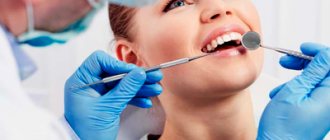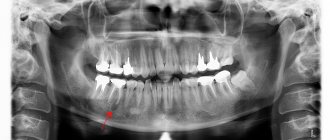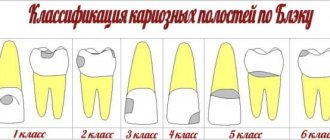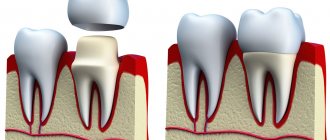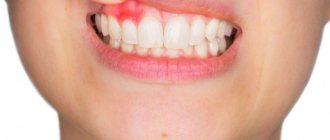Tooth abscess: what is it - symptoms and treatment
A dental abscess is an acute infectious pathology characterized by a clearly limited accumulation of pus in the root area. The purulent process is often a dangerous complication of periodontitis, periostitis, and other dental diseases. The lack of timely treatment threatens with adverse consequences not only for the affected segment, but also for the entire body. In Moscow, dental services are provided by the Center for Aesthetic Dentistry near the Otradnoye metro station. Our doctors will quickly and efficiently help eliminate any problem with sore teeth and gums.
Complications of the procedure
Complications most often develop when the problem is not treated in a timely manner. Pus can spread through the spaces around blood vessels and nerves filled with fatty tissue. The proximity of the teeth to the brain and paranasal sinuses determines the danger posed by an untreated purulent process in the tissues surrounding the tooth.
When the process is localized on the lower jaw, the pus spreads to the tissues of the neck and lymph nodes. The greatest danger in this case is damage to the adipose tissue surrounding the heart - mediastinitis.
What is a tooth abscess
An abscess in dentistry is an inflammatory process accompanied by the formation of a cavity with pus near a segment or its root. The abscess on the root of the tooth is surrounded by a dense connective tissue capsule, separating it from healthy tissue. Pyogenic bacteria penetrate into the unit through chips, cracks, and carious cavities.
During their life, microbes produce toxins that irritate the pulpal nerve receptors, which causes pain. In addition, toxic products of pathogenic flora increase vascular permeability, resulting in soft tissue swelling.
There are three main types of abscess:
- Periapical - pus accumulates at the root of the tooth (near its apex). A hilar abscess is formed due to an infectious lesion of the pulp. The etiological factor is untreated caries or periodontitis. The progressive inflammatory process spreads to the periosteum and surrounding soft tissue with the formation of a fistula and purulent lump on the gum.
- Periodontal - the focus is located inside the periodontal pockets. The cause is periodontitis. The pulp remains intact, and the infection is localized between the gum and the alveolar ridge.
- Desnevoy. Gum abscess is a purulent formation in the area of the gingival papillae between the segments.
Causes and types of disease
Tooth abscess is a heterogeneous disease. The process can affect the soft tissue of the gums, the supporting apparatus (periodontium) or be localized in close proximity to the root. Depending on this, the purulent focus is divided into gingival, periodontal and periapical.
In the case of a gingival lesion, only the soft tissues of the jaw are involved in the process. The bone, periosteum, and ligaments of the tooth are not involved in inflammation. To eliminate the typical signs of the disease - swelling and swelling of the cheek - an abscess on the gum is opened. The term flux is often used as a synonym.
The periapical purulent focus originates from inflammation of the neurovascular tissue of the tooth - the pulp. The process tends to spread to the roots of the affected organ. Since the inflammatory focus is surrounded on all sides by hard tissue and has no outlet for purulent contents, in this case the pain will be especially intense.
With a periodontal abscess, the tissues surrounding the organ and fixing it in place are affected. In this case, it is easier for the pus to create an outlet in the form of a pocket between the crown and the gum. Without opening a periodontal abscess, the infection threatens to spread to all nearby tissues.
The source of infection is present in every person every day in the oral cavity. It most often settles in areas of gum and periodontal inflammation, and hides in teeth damaged by caries or those that have suffered trauma (including fracture). In addition, the source of infection is often located in the tonsils, affected by a chronic inflammatory process - tonsillitis.
Why does a tooth fester?
Let's look at why pus forms in teeth. The causes of the pathology can be:
- mechanical damage to the oral mucosa;
- dental diseases of an infectious nature (caries, pulpitis, periodontitis, periodontitis, gingivitis, etc.);
- hematogenous spread of microbes from other foci of infection in the body (sinusitis, pneumonia, pharyngitis, tonsillitis, adnexitis, etc.);
- maxillofacial injuries accompanied by a violation of the integrity of the segment;
- insufficient oral hygiene;
- Iatrogenic causes associated with the introduction of bacteria during dental treatment.
There are risk factors, the presence of which increases the likelihood of pathology: smoking, decreased body defenses, hypothermia, chronic stress. Timely treatment of tooth root periodontitis and other dental diseases reduces the likelihood of an abscess.
Dental cyst treatment.
Once a dental cyst is discovered, the cyst itself and the associated tooth must be removed. This means that in this area we will have a significant deficiency of hard tissue, which can also cause an aesthetic problem. Using digital imaging techniques, we can now assess the size of the cyst and the extent of damage before we even begin treatment. Once the cyst is removed, we can regenerate the lost bone using guided bone regeneration or bone augmentation techniques, and then restore the missing tooth with an implant
Symptoms of gum abscess
The main symptom of the disease is pain. It has a different character (aching, pulsating, acute), is constant or occurs periodically under the influence of stress factors (cold, heat, sour, sweet foods). The pain is often worse when chewing. It can be local or spread to neighboring teeth, ears, eyes. In addition, with an abscess there are other clinical manifestations:
- hyperemia of soft tissues around the affected segment;
- swelling of the inflammation zone;
- bitter taste in the mouth;
- foul odor;
- mobility and change in the natural color of the segment;
- the presence of an ulcer on the gum with purulent discharge;
- enlargement of the submandibular lymph nodes;
- facial deformation due to swelling;
- hyperthermia, lethargy, sleep disturbance.
What is a dental cyst?
A dental cyst is an abnormal cavity that contains fluid, cells and other organic substances and is surrounded by a strong wall. A dental cyst usually develops at the tip of a tooth, at the apex, due to inflammation of the nerve (Figure 1). In other cases, a cyst may appear around a tooth that has undergone root canal treatment but the bacteria have not been completely removed (Figure 2). The unfortunate thing is that over time, a dental cyst increases in size and can cause gradual destruction of the bone and adjacent teeth (Fig. 3) or affect more sensitive tissues such as the mandibular nerve (Fig. 4) (marked with a yellow line). This is the reason why a dental cyst should be removed as soon as possible.
What to do when you have an abscess
What to do if a tooth breaks: immediately seek help from a dentist. When a fistula forms and the purulent contents drain, the person’s well-being improves and the intensity of pain decreases. However, the pathological process, when the lesion is opened independently, continues to progress and can lead to complications: mediastinitis, thrombophlebitis, sepsis, meningitis, etc.
Therefore, it is important to promptly treat inflammatory diseases of teeth and periodontium. How much it costs to treat pulpitis and other pathologies at North-Eastern Dental Center No. 1 can be found on the corresponding page of the official website.
Causes
The main cause of periodontal abscess is infection in the gum pockets, resulting in the development of purulent inflammation of the soft tissues around the tooth.
The following factors contribute to the appearance of periodontal abscess:
- Gum diseases: gingivitis, periodontitis, periodontal disease.
- Injury to the soft tissue around the tooth by hard food or a crown.
- A foreign body gets into the gum pocket (the space between the tooth and gum): a piece of food, bristles from a toothbrush.
- Tooth diseases: caries, pulpitis.
How to treat a tooth abscess
Treatment of a tooth abscess is aimed at eliminating the infectious process and relieving pain. A comprehensive program may include the following activities:
- Opening and draining the lesion. An incision is made on the gum, a drainage is installed through which the pus can freely come out. The drainage system is installed for several days. During this period, the patient is prescribed rinses with antiseptics and saline solutions.
- Endodontic treatment. It involves removing the pulp, treating the root canals with medications and filling them.
- Excision of the root apex. Surgical intervention is performed when the source of infection is located in the periapical area. The surgeon cuts the gum and removes the abscess along with the affected part of the root. The segment itself is preserved.
- Removing a unit. The need for tooth extraction occurs when there is significant destruction of the tooth.
- Therapy with broad-spectrum antibiotics.
- Restoration of the coronal part with a filling or orthopedic construction.
Rehabilitation after opening an abscess
For the speedy healing of the inflammatory focus, it is necessary to follow a number of recommendations:
- rinse the mouth with antiseptic solutions;
- take orally antibacterial drugs prescribed by a doctor;
- do not use Aspirin to reduce body temperature, since this drug slows down blood clotting and increases the risk of hematoma formation in soft tissues;
- to eliminate pain after opening an abscess, use non-steroidal anti-inflammatory drugs - Nurofen, Paracetamol, Ketorol;
- Do not use thermal procedures to eliminate painful sensations. In this case, blood flow to the infected area will increase, which will facilitate the spread of pathogenic microbes.
Treatment of the affected tooth is possible after cleansing and healing of the abscess. In this case, the specialist, when cleaning and filling the canals, may not fear the further spread of infection.
Who treats an abscess
Only a dentist can cure a tooth abscess. If you suspect an abscess, you should contact your general practitioner. He will conduct an examination and, if necessary, schedule a consultation with a dental surgeon.
Preventing a tooth abscess is easier than curing it. To do this, it is necessary to carefully observe oral hygiene, promptly eliminate inflammatory processes in the body, and visit the dentist twice a year. A balanced diet and vitamin-mineral complex products will help compensate for the lack of vitamins and minerals necessary for dental health.
Diagnostics
In the vast majority of cases, to make a diagnosis, it is enough for the doctor to conduct an examination and collect an anamnesis. But in order to clarify the location of the lesion and estimate its size, laboratory diagnostic procedures may be necessary, an X-ray examination is performed. For example, an x-ray will help make an accurate diagnosis, confirm a preliminary one, or can identify another disease that has similar symptoms.
Therefore, it is extremely important to contact a trusted clinic and entrust your dental treatment to experienced specialists.
Before visiting your doctor, do not take painkillers, even if necessary. Taking them may make it difficult to make a correct diagnosis.
Why does a white coating appear after extraction?
If white plaque appears after tooth extraction, this is normal. Dentists call it fibrinous plaque. It is the result of trauma and necrosis of the gums. No action needs to be taken. New cells that promote healing soon form under the necrotic tissue.
If the gums are swollen after tooth extraction, and soon loose white tissue appears, this is a sign of recovery. Doctors do not recommend removing the crust. It serves as protection for the injured area and usually resolves on its own.


